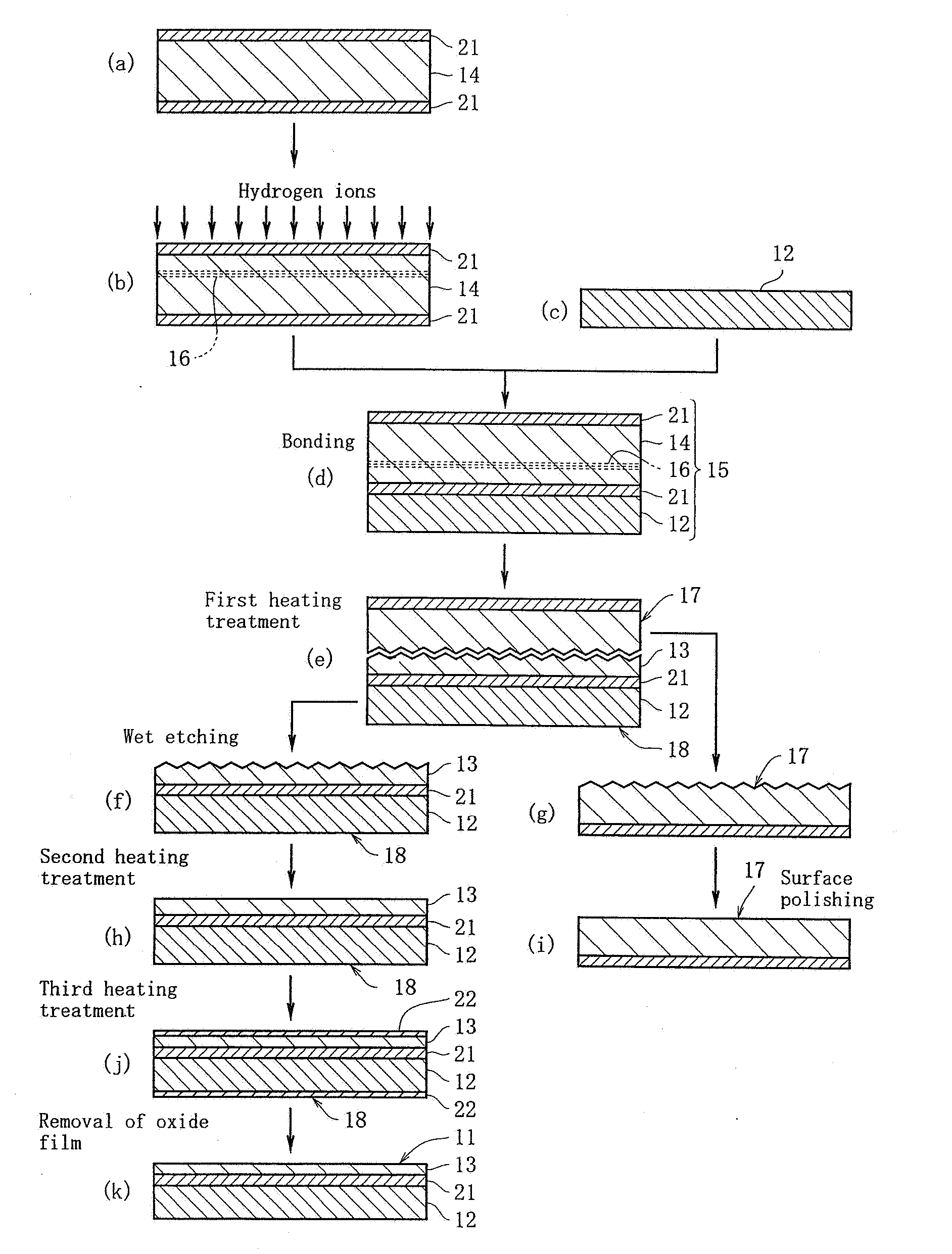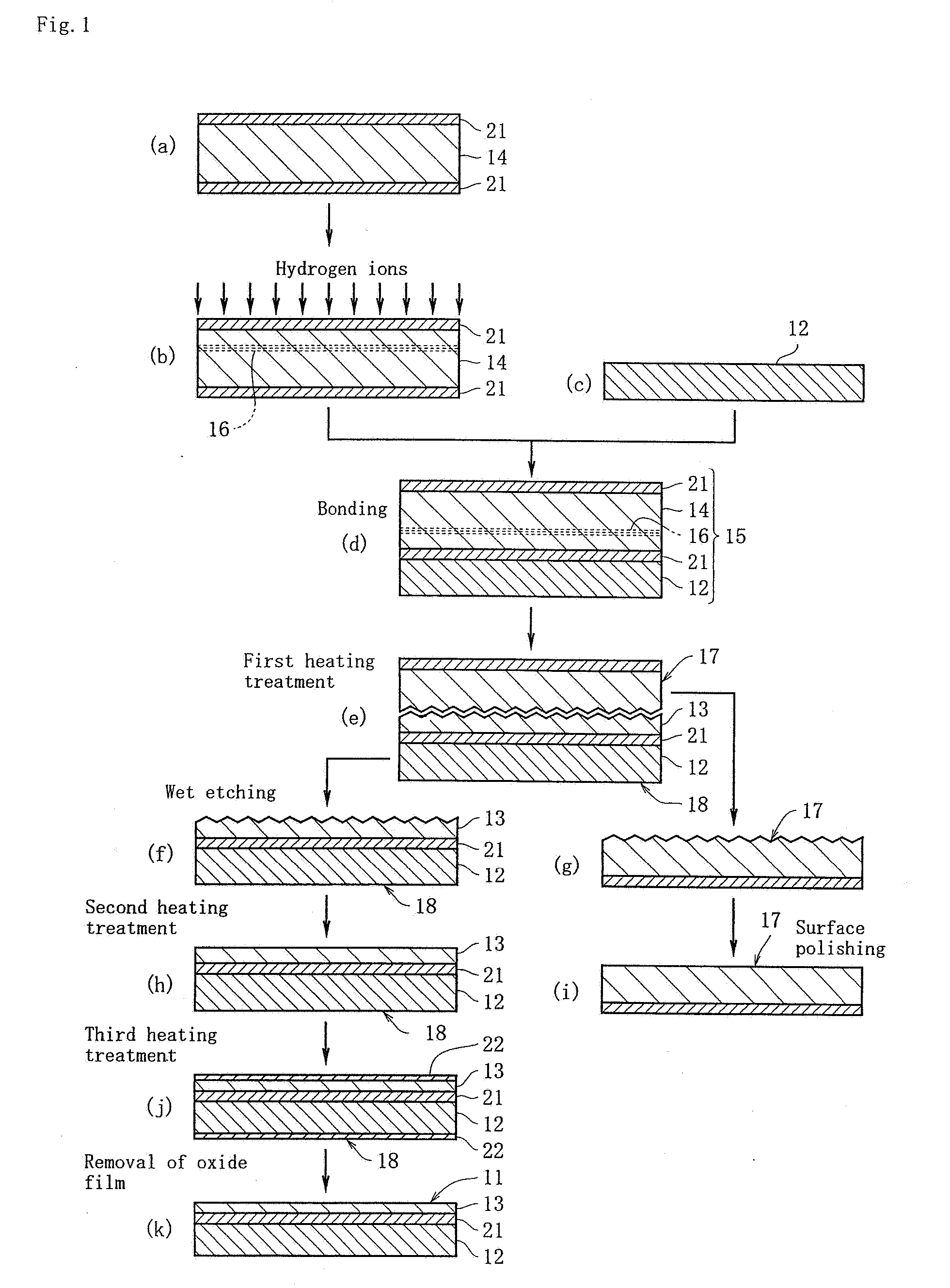Method for Manufacturing SOI Substrate
a technology of soi and substrate, which is applied in the direction of semiconductor/solid-state device manufacturing, basic electric elements, electric apparatus, etc., can solve the problems of increasing the incidence of crystal defects, and achieve the effects of reducing damage, enhancing the bonding strength of the bonded substrate, and uniform thickness of the soi layer
- Summary
- Abstract
- Description
- Claims
- Application Information
AI Technical Summary
Benefits of technology
Problems solved by technology
Method used
Image
Examples
example 1
[0038] As shown in FIG. 1, first a disc-shaped (outer diameter, 200 mm and thickness, 0.725 mm) first silicon substrate 14 composed of silicon single crystal was subjected to a heating treatment consisting of heating at 1000° C. for 5 hours in an oxygen atmosphere, to allow a first oxide film 21 to be formed on the top and bottom surfaces of the first silicon substrate 14 as well as its side surfaces. The first oxide film 21 has a thickness of about 150 nm. Then, implantation of hydrogen ions into a surface of the first silicon substrate 14 was performed by radiating a beam of hydrogen ions at a dose of 6×1016 atoms / cm2 under an acceleration voltage of 50 keV. Through this operation, an ion-implantation zone 16 is formed in the interior of the first silicon substrate 14 (FIG. 1(b)). The depth of the ion-implantation zone 16 (in terms of the level at which the density of implanted hydrogen ions had a peak) from the top surface was determined to be about 500 nm with the thickness of f...
example 2
[0040] A bonded substrate 18 was subjected to wet etching so that SOI layer 13 was thinned until its thickness was 300 nm. Not being subjected to a second heating treatment consisting of heating at 900° C., the bonded substrate 18 was immediately subjected to a heating treatment consisting of heating at 1100° C. for 120 minutes in an atmosphere of argon. Except for this alteration, the bonded substrate 18 was processed in the same manner as in Example 1 to manufacture an SOI substrate. This SOI substrate was made Example 2.
example 3
[0041] Not being subjected to wet etching, a bonded substrate 18 immediately received a second heating treatment consisting of heating at 900° C. for 90 minutes in an oxygen atmosphere, and third heating treatment consisting of heating at 1100° C. for 120 minutes in an oxygen atmosphere in this order. Except for this alteration, the bonded substrate 18 was processed in the same manner as in Example 1 to manufacture an SOI substrate. This SOI substrate was made Example 3.
PUM
| Property | Measurement | Unit |
|---|---|---|
| thickness | aaaaa | aaaaa |
| temperature | aaaaa | aaaaa |
| thickness | aaaaa | aaaaa |
Abstract
Description
Claims
Application Information
 Login to View More
Login to View More - R&D
- Intellectual Property
- Life Sciences
- Materials
- Tech Scout
- Unparalleled Data Quality
- Higher Quality Content
- 60% Fewer Hallucinations
Browse by: Latest US Patents, China's latest patents, Technical Efficacy Thesaurus, Application Domain, Technology Topic, Popular Technical Reports.
© 2025 PatSnap. All rights reserved.Legal|Privacy policy|Modern Slavery Act Transparency Statement|Sitemap|About US| Contact US: help@patsnap.com


